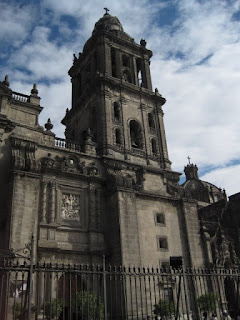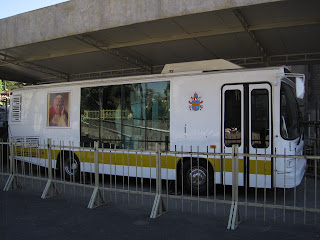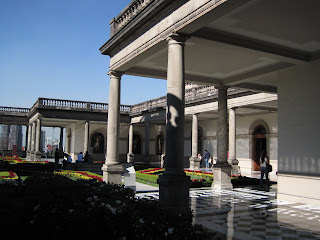We stayed in the Hotel Rioja on Av. Cinco de Mayo, just down from the Zócalo and the cathedral which was built between 1567 and 1788. Just beyond the cathedral lie the remains of the Templo Mayor of Tenochtitlán, the Nahua city founded in 1325 where Mexico City now stands. The city is full of this layering of centuries of history, and pre-Columbian remains are still being excavated downtown.
The old city of Tenochtitlán was built on an island in the middle of what was once Lake Texcoco. When the Spanish conquered the region they drained the lake and built on the reclaimed land. Many of the older buildings in town are visibly leaning as they slowly sink into this soft ground.
Beneath these sinking buildings Mexico City has an outstanding Metro system, supplemented by a zero-emissions bus system -- both very useful during the heavy rain we had our first few days. The Metro has a feature I haven't seen anywhere else: sex segregation during rush hour. Early morning and late afternoon there are separate walkways for women and kids and for men. Women have the option to get on any train car at these times but most choose the women's only cars. Men have to squash into the men's cars. I have to say, it felt awfully civilized.
Mexico City is full of museums and we took a fair shot at trying to see them all, (full disclosure: we purposely skipped the interactive museum of the economy):
Catedral Metropolitana

Templo Mayor, Tenochtitlán



Museo Nacional de Arte







Museo Mural de Diego Rivera



The archaelogical site of Teotihuacán is about an hour from the city, a wonderful complex of 3 giant pyramids connected by a long avenue flanked by smaller structures. The Temple of the Sun is the most immense (now thought to be a temple to the rain god Tlaloc rather than to the sun) but the Temple of Quetzalcoatl is the most remarkable. It was covered with carvings of feathered serpents and shells and the ones that remain give a bit of a sense of how amazing it looked. There is a great recreation of part of it at the Anthropology Museum.








Monument to Los Niños Héroes

Museo de Arte Moderno





Los Voladores de Papantla





Museo Nacional de Antropología



















El Borcegui Museo del Calzado -- the Shoe Museum!







Pastelería La Ideal





Antiguo Colegio de San Ildefonso




Museo de Arte Popular



Biblioteca de México




Teatro de la Ciudad

Cámara de Diputados

Basilica de Santa María de Guadalupe









Museo de Casa de León Trotsky (Mike's great-grandfather was a member of the Dewey Commission charged investigating Stalin's charges against him.)



Museo Frida Kahlo

Palacio Postal

Castillo de Chapultepec (National History Museum)









Museo de la Caricatura



Palacio de las Bellas Artes
The exterior of this white marble Beaux Arts confection conceals a pure art deco interior, both periods of decoration containing interpretations of pre-Columbian motifs. The limited collection it houses isn't so hot but the building is wonderful.








I think the main thing that will stick with me from this trip is how much more intimately real other places in the world are once you've been there. And I am going to try to resist making the mistake of taking the day's front page horror story about someplace in the world as a coherent social assessment of the entire nation. Yes, terrible things have been happening in Chihuahua state, but the idea of all Mexico as a more than normally dangerous place, let alone a failed state, is nuts.
From D.F. (which stands for Distrito Federal, by the way) we caught a bus to Zitácuaro, our jumping off point for the renowned and eminently peaceable monarch butterfly reserve.

No comments:
Post a Comment